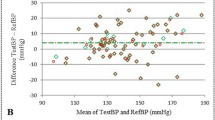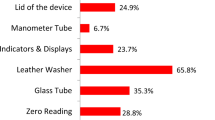Abstract
The benefit of the central systolic blood pressure (cSBP) has already been recognized, but its general measurement in the everyday routine is still limited mainly because available established non-invasive assessment devices are not suitable for everyday use. In this study, we investigated the performance of an oscillometric device Tel-O-GRAPH for cSBP assessment in terms of suitability for everyday clinical use. One hundred and three patients were prospectively included. cSBP was computed by Tel-O-GRAPH compared with Sphygmocor using applanation tonometry. There was a good agreement between Tel-O-GRAPH and Sphygmocor for cSBP (mean difference±s.d.: −0.3±6.7 mm Hg; Pearson’s R=0.95; P<0.0001). Recorded cSBP values in the supine vs seated position and for the experienced vs non-experienced user did not significantly differ (mean cSBPsupine 122.1±13.9 mm Hg vs cSBPseated 120.7±15.7 mmHg; cSBPnon-experienced 120.6±20.5 mm Hg and cSBPexperienced 119.2±19.9 mm Hg). The mean difference of cSBP between supine and seated positions was 1.5±6.8 and −1.4±5.0 mm Hg between experienced and non-experienced users. This study showed good accuracy in assessing cSBP with an oscillometric BP measurement device Tel-O-GRAPH compared with a Sphygmocor. Furthermore, the calculation of cSBP by Tel-O-GRAPH appears to be easy and can be done during the routine brachial BP measurement. Computed cSBP values seem to remain reliable independently of the patient body position and experience of the operator. Consequently, the easiness of utilization and reliability of the device may open the opportunity for its extended use in everyday clinical practice, as well as reliable alternative for clinical studies, making complex applanation tonometry dispensable.
This is a preview of subscription content, access via your institution
Access options
Subscribe to this journal
Receive 12 digital issues and online access to articles
$119.00 per year
only $9.92 per issue
Buy this article
- Purchase on Springer Link
- Instant access to full article PDF
Prices may be subject to local taxes which are calculated during checkout




Similar content being viewed by others
References
Roman MJ, Devereux RB, Kizer JR, Lee ET, Galloway JM, Ali T et al. Central pressure more strongly relates to vascular disease and outcome than does brachial pressure: the Strong Heart Study. Hypertension 2007; 50 (1): 197–203.
Roman MJ, Okin PM, Kizer JR, Lee ET, Howard BV, Devereux RB . Relations of central and brachial blood pressure to left ventricular hypertrophy and geometry: the Strong Heart Study. J Hypertens 2010; 28 (2): 384–388.
Safar ME, Blacher J, Pannier B, Guerin AP, Marchais SJ, Guyonvarc'h PM et al. Central pulse pressure and mortality in end-stage renal disease. Hypertension 2002; 39 (3): 735–738.
Wang KL, Cheng HM, Chuang SY, Spurgeon HA, Ting CT, Lakatta EG et al. Central or peripheral systolic or pulse pressure: which best relates to target organs and future mortality? J Hypertens 2009; 27 (3): 461–467.
Karamanoglu M, O'Rourke MF, Avolio AP, Kelly RP . An analysis of the relationship between central aortic and peripheral upper limb pressure waves in man. Eur Heart J 1993; 14 (2): 160–167.
Wassertheurer S, Kropf J, Weber T, van der Giet M, Baulmann J, Ammer M et al. A new oscillometric method for pulse wave analysis: comparison with a common tonometric method. J Hum Hypertens 2010; 24 (8): 498–504.
Safar ME, Blacher J . Carotid versus brachial pulse pressure in elderly persons. J Am Coll Cardiol 2008; 51 (25): 2440–2441.
McEniery CM, Yasmin, McDonnell B, Munnery M, Wallace SM, Rowe CV et alAnglo-Cardiff Collaborative Trial I. Central pressure: variability and impact of cardiovascular risk factors: the Anglo-Cardiff Collaborative Trial II. Hypertension 2008; 51 (6):1476–1482.
Avolio AP, Van Bortel LM, Boutouyrie P, Cockcroft JR, McEniery CM, Protogerou AD et al. Role of pulse pressure amplification in arterial hypertension: experts' opinion and review of the data. Hypertension 2009; 54 (2): 375–383.
Weber T, Wassertheurer S . Moving on—on average in the right direction?: noninvasive methods to estimate central blood pressure. Hypertension 2014; 63 (4): 665–667.
Salvi P, Lio G, Labat C, Ricci E, Pannier B, Benetos A . Validation of a new non-invasive portable tonometer for determining arterial pressure wave and pulse wave velocity: the PulsePen device. J Hypertens 2004; 22 (12): 2285–2293.
Karamanoglu M, Feneley MP . Derivation of the ascending aortic-carotid pressure transfer function with an arterial model. Am J Physiol 1996; 271 (6 Pt 2): H2399–H2404.
Picone DS, Climie RE, Ahuja KD, Keske MA, Sharman JE . Brachial-to-radial SBP amplification: implications of age and estimated central blood pressure from radial tonometry. J Hypertens 2015; 33 (9):1876–1883 discussion 1883.
Weber T, Wassertheurer S, Rammer M, Maurer E, Hametner B, Mayer CC et al. Validation of a brachial cuff-based method for estimating central systolic blood pressure. Hypertension 2011; 58 (5): 825–832.
Rossen NB, Laugesen E, Peters CD, Ebbehoj E, Knudsen ST, Poulsen PL et al. Invasive validation of arteriograph estimates of central blood pressure in patients with type 2 diabetes. Am J Hypertens 2014; 27 (5): 674–679.
Pucci G, Cheriyan J, Hubsch A, Hickson SS, Gajendragadkar PR, Watson T et al. Evaluation of the Vicorder, a novel cuff-based device for the noninvasive estimation of central blood pressure. J Hypertens 2013; 31 (1): 77–85.
Horvath IG, Nemeth A, Lenkey Z, Alessandri N, Tufano F, Kis P et al. Invasive validation of a new oscillometric device (Arteriograph) for measuring augmentation index, central blood pressure and aortic pulse wave velocity. J Hypertens 2010; 28 (10): 2068–2075.
Costello BT, Schultz MG, Black JA, Sharman JE . Evaluation of a brachial cuff and suprasystolic waveform algorithm method to noninvasively derive central blood pressure. Am J Hypertens 2015; 28 (4): 480–486.
O'Brien E, Petrie J, Littler W, de Swiet M, Padfield PL, Altman DG et al. An outline of the revised British Hypertension Society protocol for the evaluation of blood pressure measuring devices. J Hypertens 1993; 11 (6): 677–679.
Reshetnik AGC, Harsch-Gladisch C, Zidek W, Tölle M, van der Giet M . Validation of the Tel-O-GRAPH, a new oszillometric blood-pressure measuring device, according to British Hypertension Society (BHS) protocol. Blood Press Monit (in press).
Wassertheurer S, Mayer C, Breitenecker F . Modeling arterial and left ventricular coupling for non-invasive measurements. Simul Model Pract Theory 2008; 16 (8): 988–997.
McEniery CM, Spratt M, Munnery M, Yarnell J, Lowe GD, Rumley A et al. An analysis of prospective risk factors for aortic stiffness in men: 20-year follow-up from the Caerphilly prospective study. Hypertension 2010; 56 (1): 36–43.
Townsend RR, Wimmer NJ, Chirinos JA, Parsa A, Weir M, Perumal K et al. Aortic PWV in chronic kidney disease: a CRIC ancillary study. Am J Hypertens 2010; 23 (3): 282–289.
O'Brien E, Petrie J, Littler W, de Swiet M, Padfield PL, Altman DG et al. The British Hypertension Society protocol for the evaluation of blood pressure measuring devices. J Hypertens 1993; 11 (suppl 2): 43–62.
White WB, Berson AS, Robbins C, Jamieson MJ, Prisant LM, Roccella E et al. National standard for measurement of resting and ambulatory blood pressures with automated sphygmomanometers. Hypertension 1993; 21 (4): 504–509.
Climie RE, Schultz MG, Nikolic SB, Ahuja KD, Fell JW, Sharman JE . Validity and reliability of central blood pressure estimated by upper arm oscillometric cuff pressure. Am J Hypertens 2012; 25 (4): 414–420.
Weiss W, Gohlisch C, Harsch-Gladisch C, Tolle M, Zidek W, van der Giet M . Oscillometric estimation of central blood pressure: validation of the Mobil-O-Graph in comparison with the SphygmoCor device. Blood Press Monit 2012; 17 (3): 128–131.
Author information
Authors and Affiliations
Corresponding author
Ethics declarations
Competing interests
The authors declare no conflict of interest.
Additional information
Supplementary Information accompanies the paper on Journal of Human Genetics website
Supplementary information
Rights and permissions
About this article
Cite this article
Reshetnik, A., Gohlisch, C., Zidek, W. et al. Central blood pressure assessment using oscillometry is feasible for everyday clinical practice. J Hum Hypertens 30, 737–741 (2016). https://doi.org/10.1038/jhh.2016.21
Received:
Revised:
Accepted:
Published:
Issue Date:
DOI: https://doi.org/10.1038/jhh.2016.21



